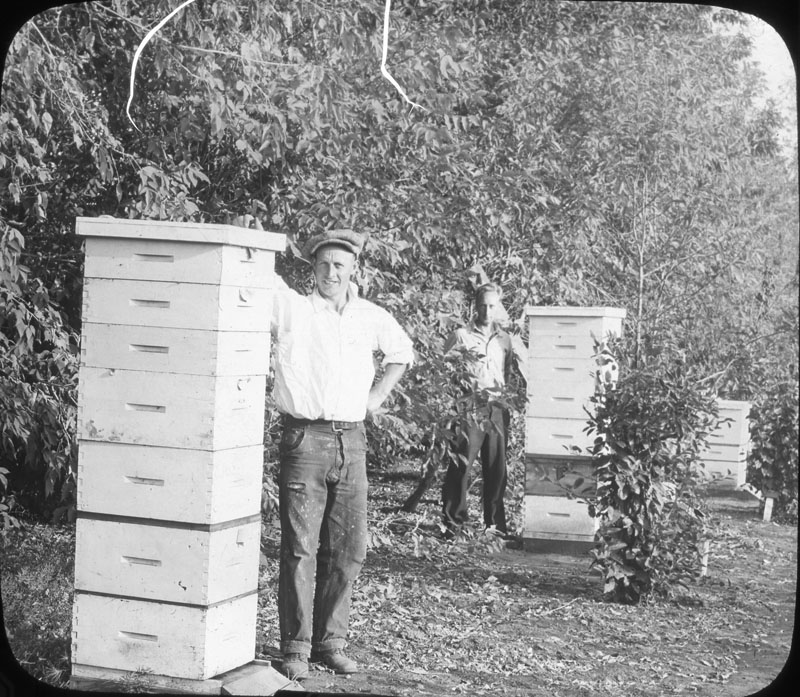Image: “Foster and Crossley with hives, 1934.” Photograph by W.D. Albright (SPRA 362.02.03.06)
The Archives are buzzing with information about bees! Both archival collections and reference files include a bounty of information about beekeeping (apiculture) in the South Peace. The W.D. Albright fonds (fonds 362) contains references and photographs on early hives at the Beaverlodge Experimental Sub-Station (later, Station and then, Farm) and more broadly in the region. The Beekeeping reference file (Agriculture Subseries 510.01.14) contains dozens of clippings dating from 1975 to present day that document local beekeepers (apiculturists), honey producers, and researchers.
Bees and apiculture play an key role in agriculture, especially in the South Peace area. As settlers cleared land and planted crops, some used beekeeping to supplement, and even ensure, their food security. Bees support pollination of a variety of crops. In turn, forage crops such as alfalfa, clover, and canola provide rich nectar for honey bees. When tended properly, a small hive would produce honey that could be sold, traded, and eaten during the off-seasons.
The Beaverlodge Experimental Sub-Station began keeping bees in 1922. Besides those at the Sub-Station, W.D. Albright identified several early beekeepers: E.D. Prevost of Wanham, H. Hartley of Hythe, Cunningham of Grande Prairie and Rio Grande, Frank Guthrie of Grande Prairie, Gordon Hamilton of Clairmont, and “others whose names may have escaped us.” By the 1950s, local beekeepers maintained as many as 5,000 colonies in the region. In its heyday, the Peace River area claimed to be one of Canada’s biggest and best honey districts, producing about 40 percent of Alberta’s honey. For twenty years, local beekeepers and honey producers experienced widespread success.
The Beekeeping reference file also documents the steady decline of Peace River honey production, beginning in the 1970s. As modern farm machinery began transforming agriculture, bees and beekeepers struggled to adapt. In 1991, the Herald-Tribune reported that local honey production had declined by 60 percent in the past decade; honey prices, import bans on US bees, and weather were all blamed for the losses (Herald-Tribune, 15 November 1991). Meanwhile, the public was increasingly aware of the importance of bees.
In 2012, the Beaverlodge Research Farm opened the Honeybee Diagnostic Centre– Canada’s first national honeybee diagnostic centre. The Centre was created as a partnership between Grande Prairie Regional College and Agriculture and AgriFood Canada, focusing on honeybee mortality rates and causes.
Beekeeping remains popular in the South Peace. In 2015, the Grande Prairie Beekeeper Club was formed to encourage sharing knowledge and experience amongst local hobbyists. In 2018, bee enthusiasts gathered at the Beaverlodge Experimental Farm for the 65th Annual Beekeepers’ Field Day. The same year, the National Honeybee Diagnostic Centre received operational funding for another 5 years.
Bees and archives have more in common than you might think. The collections at the South Peace Regional Archives document the history of flowers, yes, but also essential food production in our area: 97 years of beekeeping in the South Peace! Like bees, archives are a valuable resource for ensuring the prosperity of future generations. And, like bees, Archives must be managed and cared for to ensure their long term success.
This article was originally featured in the June 2019 issue of Telling Our Stories.
